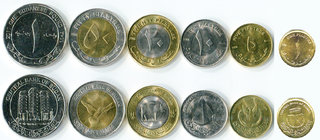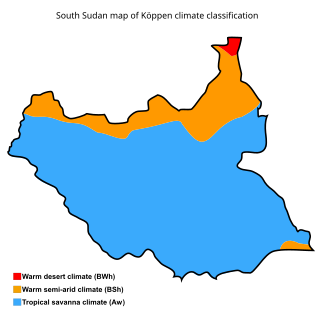Until the second half of 2002, Sudan's economy boomed on the back of increases in oil production, high oil prices, and large inflows of foreign direct investment. GDP growth registered more than 10% per year in 2006 and 2007. From 1997 to date, Sudan has been working with the IMF to implement macroeconomic reforms, including a managed float of the exchange rate. Sudan began exporting crude oil in the last quarter of 1999.

Omar Hassan Ahmad al-Bashir is a Sudanese politician who served as the seventh President of Sudan from 1989 to 2019 and founder of the National Congress Party. He came to power in 1989 when, as a brigadier in the Sudanese Army, he led a group of officers in a military coup that ousted the democratically elected government of prime minister Sadiq al-Mahdi after it began negotiations with rebels in the south. Since then, he has been elected three times as President in elections that have been under scrutiny for electoral fraud. In March 2009, al-Bashir became the first sitting president to be indicted by the International Criminal Court (ICC), for allegedly directing a campaign of mass killing, rape, and pillage against civilians in Darfur.

Jaafar Muhammad an-Nimeiry was the President of Sudan from 1969 to 1985.

Unity, sometimes known as Western Upper Nile, was one of the 10 states of South Sudan. Unity state was in the Greater Upper Nile region. It had an area of 38,837 square kilometres (14,995 sq mi). Unity was inhabited predominantly by two ethnic groups: the Nuer majority, and the Dinka minority.

The Sudanese pound (Arabic: جنيه سوداني is the basic unit of the Sudanese currency. The pound consists of 100 piasters. The pound is issued by the Central Bank of Sudan. Its value is linked to gold and convertible into foreign currencies. There are no restrictions on money transfers to and from Sudan. The Sudanese pound is equivalent to $ 0.021. It has been pegged to the United States dollar since around 1984.

The Muglad Basin is a large rift basin in Northern Africa. The basin is situated within southern Sudan and South Sudan, and it covers an area of approximately 120,000 square kilometres (46,000 sq mi) across the two nations. It contains a number of hydrocarbon accumulations of various sizes, the largest of which are the Heglig and Unity oil fields. During the 1960s and 1970s, Chevron made the first oil discoveries in the basin near the towns of Bentiu, Malakal, and Muglad. Taken together, the Muglad and Melut rift basins account for the majority of Sudan's known oil reserves.

The Melut Basin is a rift basin in South Sudan. It is situated in the states of Upper Nile and Jonglei, south of the capital Khartoum and east of the river Nile. The Basin contains several hydrocarbon accumulations, although oil exploration, as elsewhere in Sudan, has been hindered by conflict. The largest oil field in the Basin is the Great Palogue Field with estimated reserves of 900 million barrels. The Melut oil export pipeline travels 1,380 km from Palogue to Port Sudan on the Red Sea, and has been on stream since June 2006.
The Bengangai Game Reserve is found in South Sudan. Established in 1939, it is both a game reserve and an Important Bird Area. This site covers 170 square kilometres (17,000 ha). Chimpanzees are thought to habitate the game reserve; however, there is no recent information on their population.

The Imatong Mountains are mainly located in Imatong State in southeastern South Sudan, and extend into the Northern Region of Uganda. It was earlier a part of Eastern Equatoria before reorganisation of states.

South Sudan, officially known as the Republic of South Sudan, is a landlocked country in East-Central Africa. The country gained its independence from the Republic of the Sudan in 2011, making it the newest country with widespread recognition. Its capital and largest city is Juba.

The geography of South Sudan describes the physical features of South Sudan, a country in East Africa. South Sudan is a landlocked country and borders - clockwise - Sudan from the north, Ethiopia from the east, Kenya, Uganda and the Democratic Republic of the Congo from the south and the Central African Republic from the west.

India–South Sudan relations refers to the bilateral ties between the Republic of India and the Republic of South Sudan. India recognised South Sudan on 9 July 2011, the day South Sudan became an independent state. India maintains an embassy at Juba, and South Sudan maintains an embassy in New Delhi.

The wildlife of South Sudan refers to the natural flora and fauna of South Sudan. South Sudan includes the Sudd, one of the world's largest wetlands. According to the American biologist and conservationist, J. Michael Fay, South Sudan "could present the biggest migration of large mammals on earth", while Wildlife Conservation Society (WCS) reports southeast Sudan has a migration of 1.3 million antelopes. The region has a low density human population, with approximately 7 million people spread over approximately 619,745 km2 (239,285 sq mi).

Ez Zeraf Game Reserve is a 675,000-hectare (1,670,000-acre) protected area in northern South Sudan. It was designated in 1939 when the area was within Sudan.

The Kidepo Game Reserve is a protected area located in Bira, Kidepo Valley County, Eastern Equatoria State, South Sudan, Africa. Three quarters of the Kidepo Valley Reserve park is in Bira, which is inhabited by the Ketebo people and the word "Kidepo" come from the Ketebo word "Kidebo", which mean "Help us". However, Sudan deployed some game rangers in Bira during 1976 – 1983 immediately the war broke out in 1983. With an area of 1200 Km2 this reserve is located 4° 04'N and 33° 28'E on the South Sudan/Uganda border where it forms a contiguous ecosystem with Uganda's Kidepo Valley National Park. Main mammal species of the reserve include, among others, elephants, wild dogs, lions, cheetahs, leopards, hyenas, lesser kudu, buffalos, and Giraffe. The present conservation status of these and many other mammals, birds, reptiles and amphibians is not known. It is likely that due to the protracted war and many other conservation challenges listed below the numbers of wildlife have been reduced in a similar way as those in 80ma, Nimule and Southern National Parks. It is a game reserve and Important Bird Area. The 1,200 square kilometres (460 sq mi) savannah grassland and woodland habitat features key species of Heuglin's francolin and elephant.

Radom National Park is a biosphere reserve in South Darfur, Sudan, Africa.

The Kafia Kingi area is a mineral-rich region on the border between Sudan, South Sudan and the Central African Republic. It is disputed among South Sudan and Sudan.

The mining industry of Sudan was mostly driven by extraction fuel minerals, with petroleum accounting for a substantial contribution to the country's economy, until the autonomous region of Southern Sudan became an independent country in July 2011. Gold, iron ore, and base metals are mined in the Hassai Gold Mine. Chromite is another important mineral extracted from the Ingessana Hills. Other minerals extracted are gypsum, salt, and cement. Phosphate is found in Mount Kuoun and Mount Lauro in eastern Nuba. Reserves of zinc, lead, aluminium, cobalt, nickel in the form of block sulfides, and uranium are also established. Large reserves of iron ore have been established.
South Sudan, a country in northeastern Africa, became an independent country in 2011. South Sudan has the world's second largest animal migration and therefore is considered a good place for ecotourism, but the lack of infrastructure for tourism and ongoing civil war are considered the challenges for the tourism industry in South Sudan.















